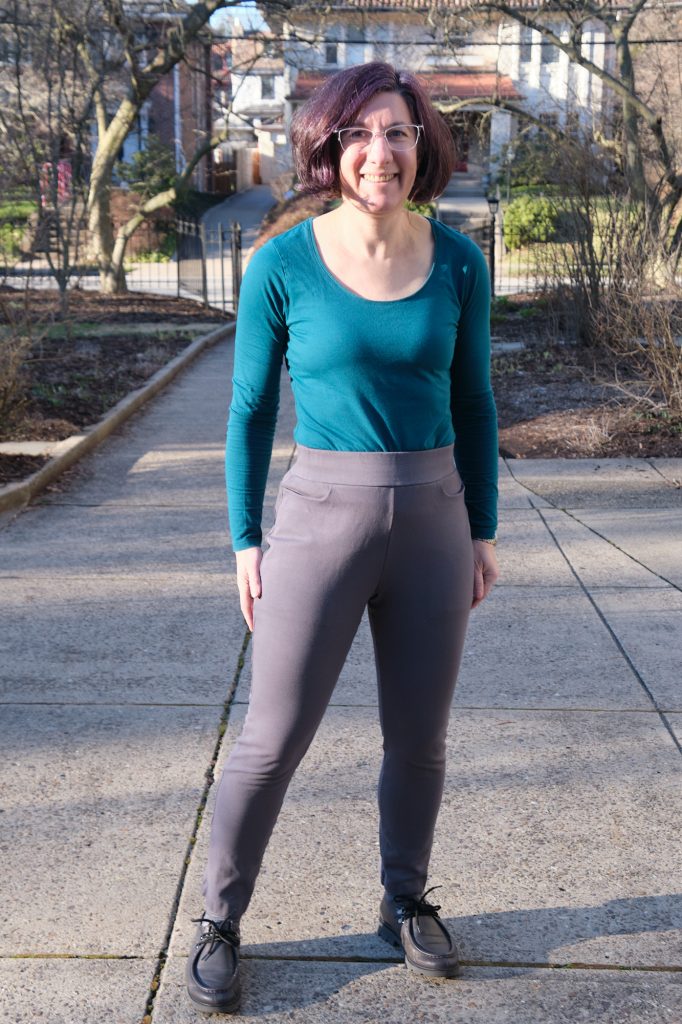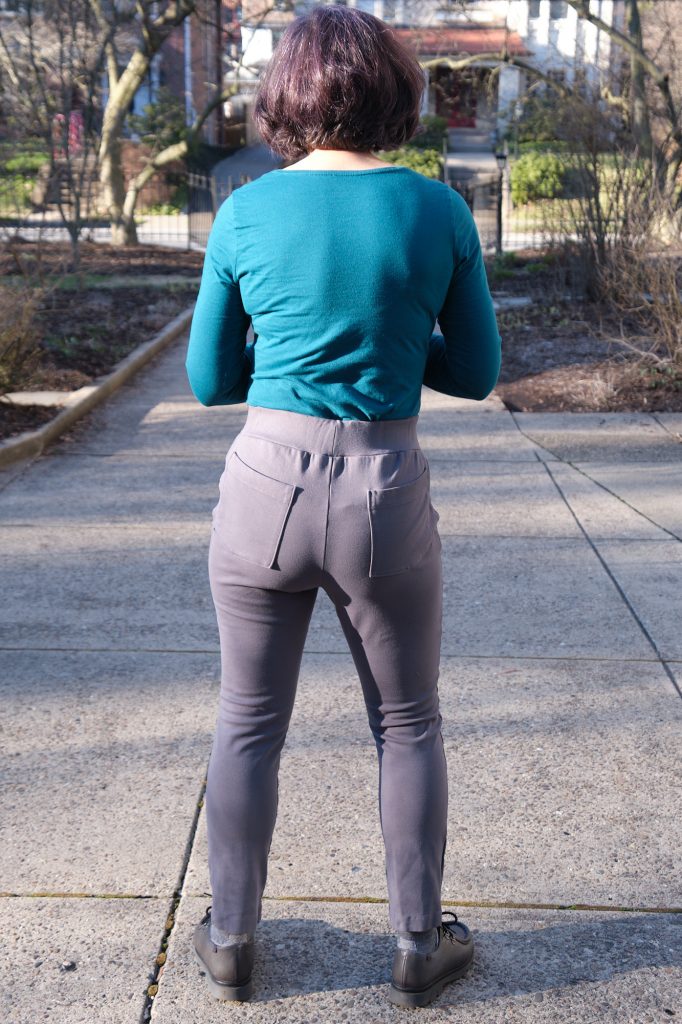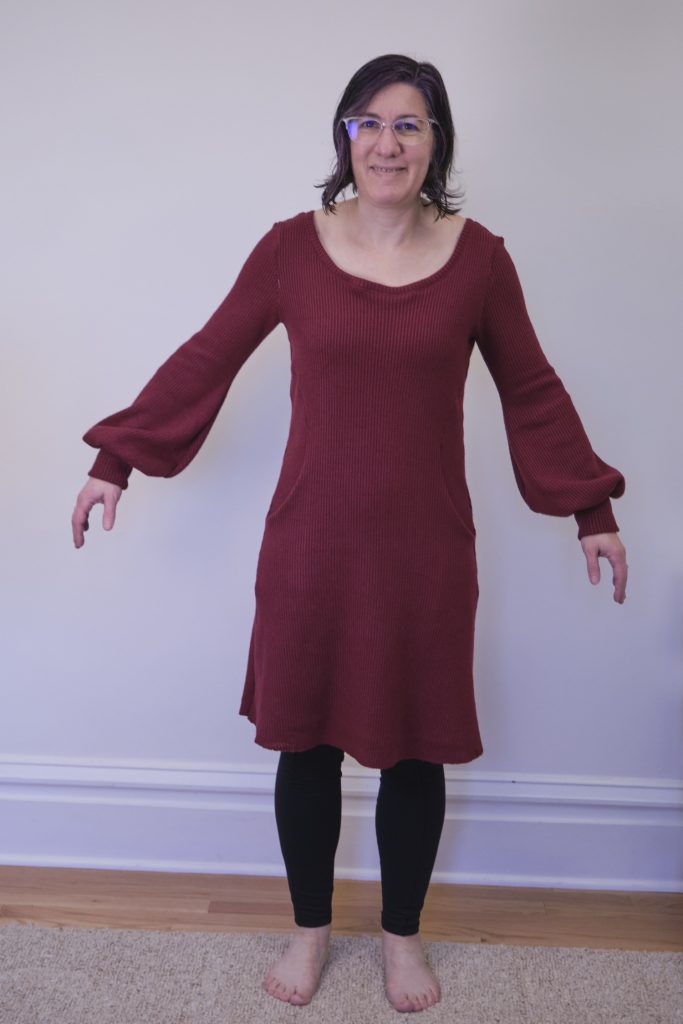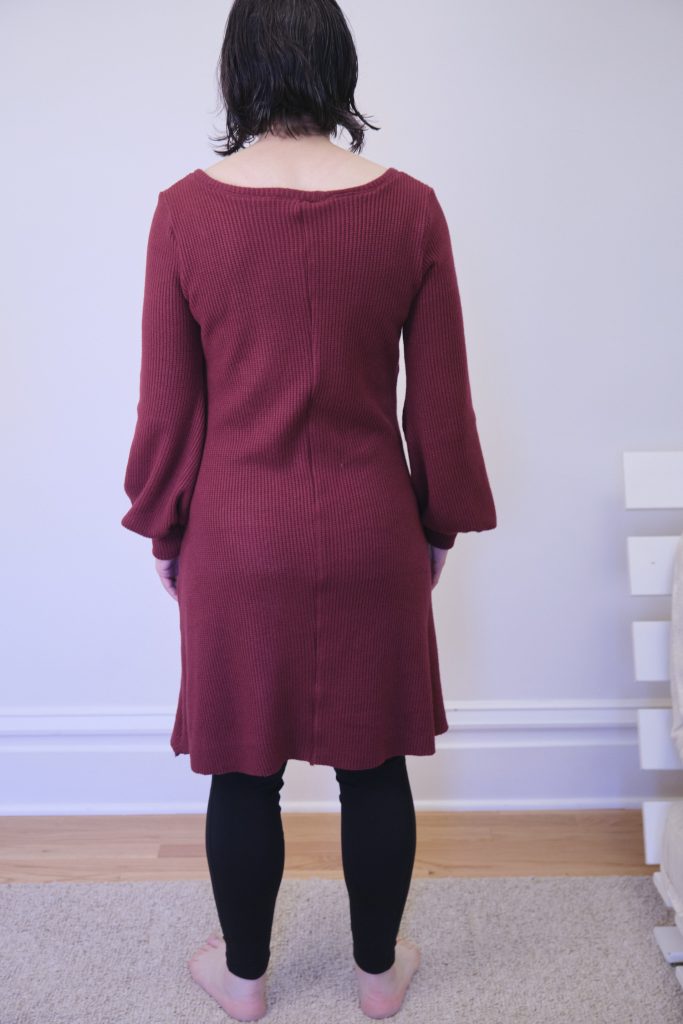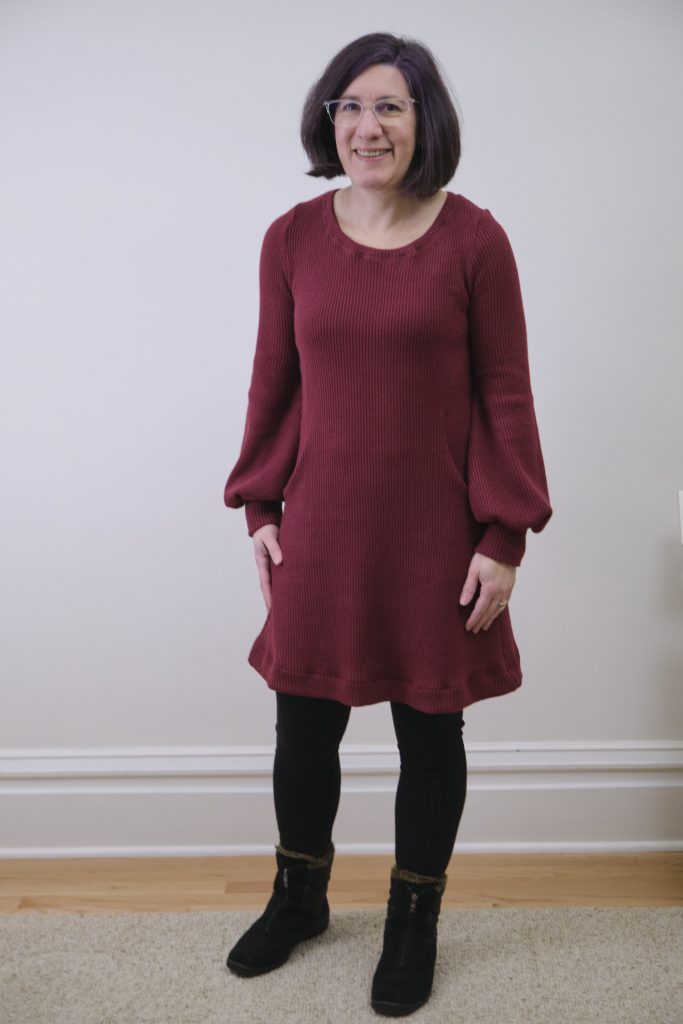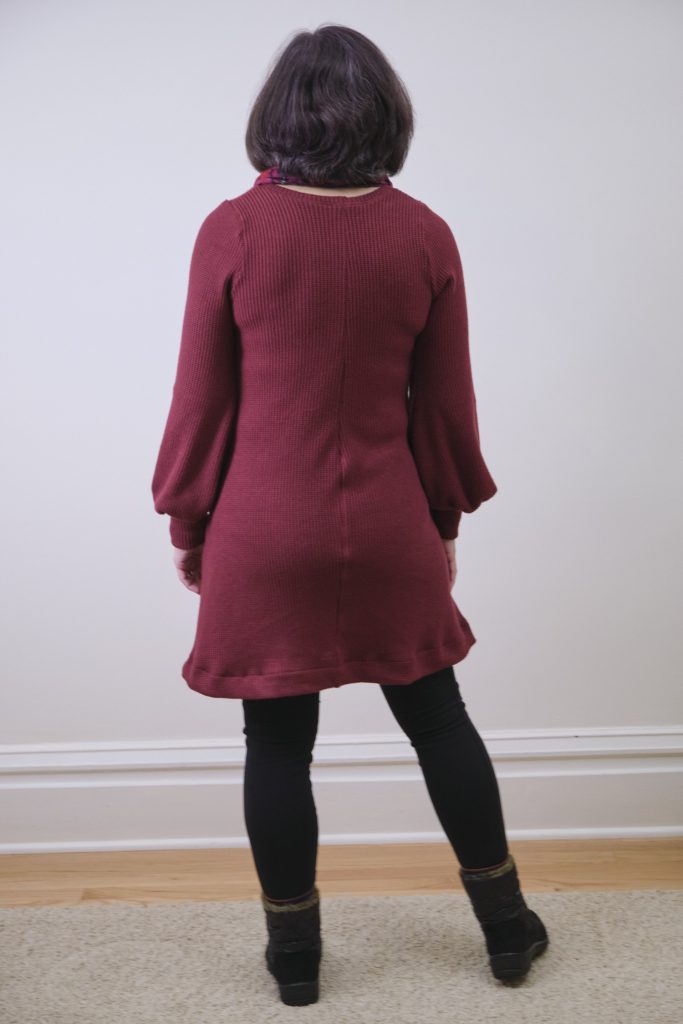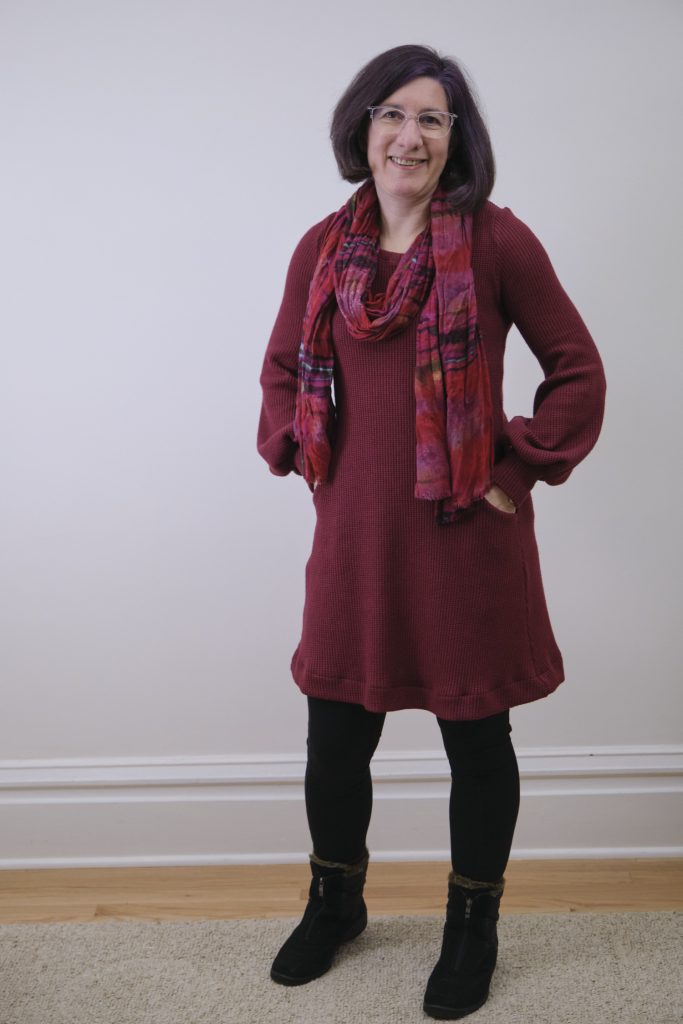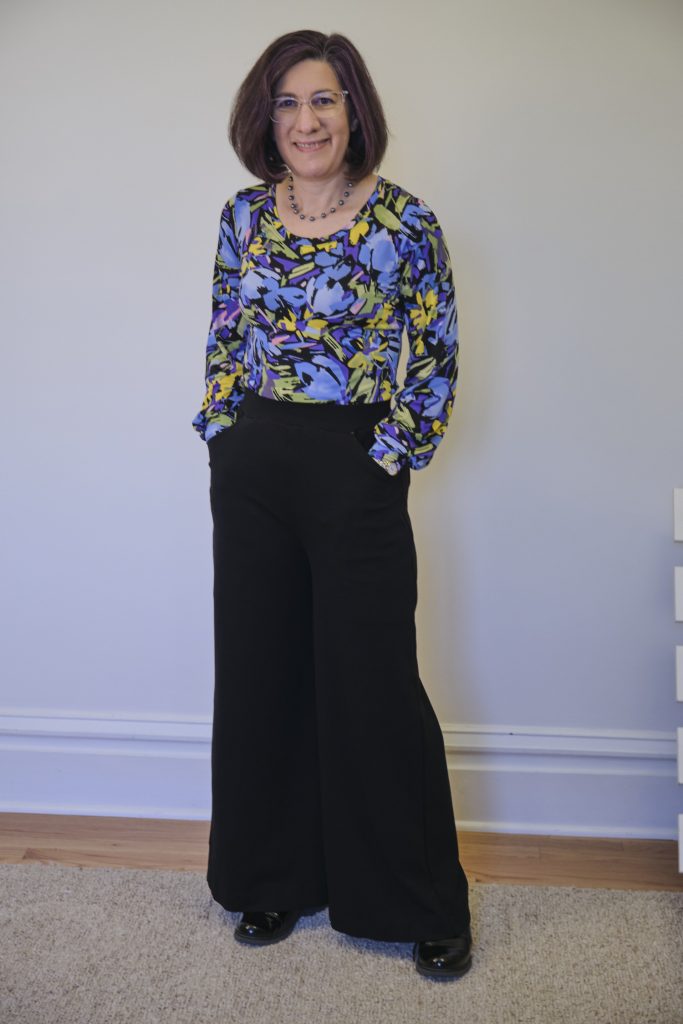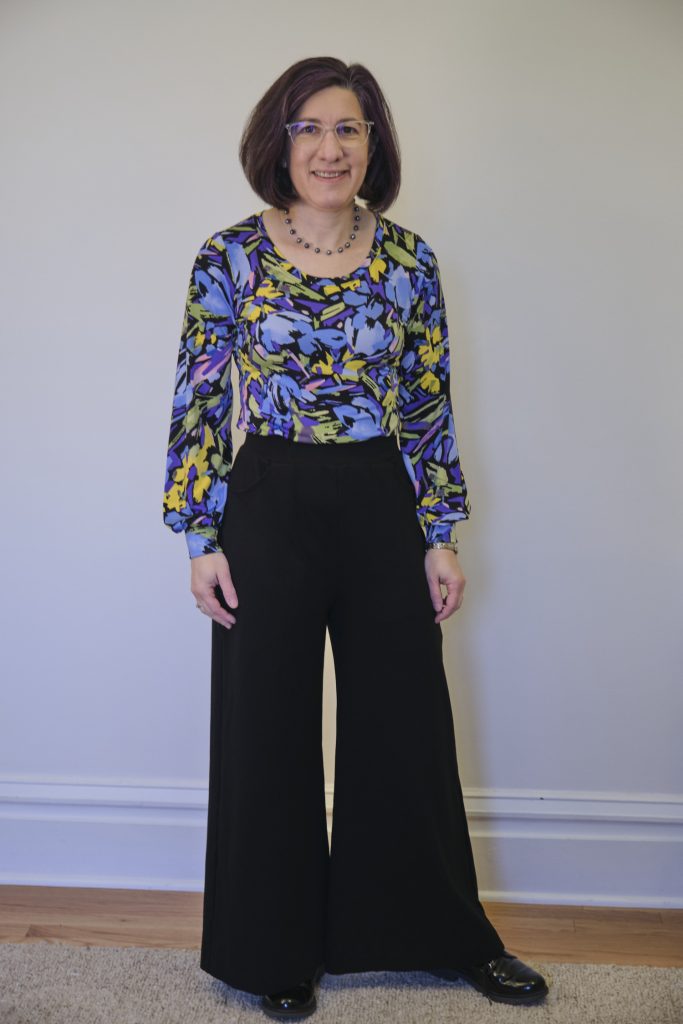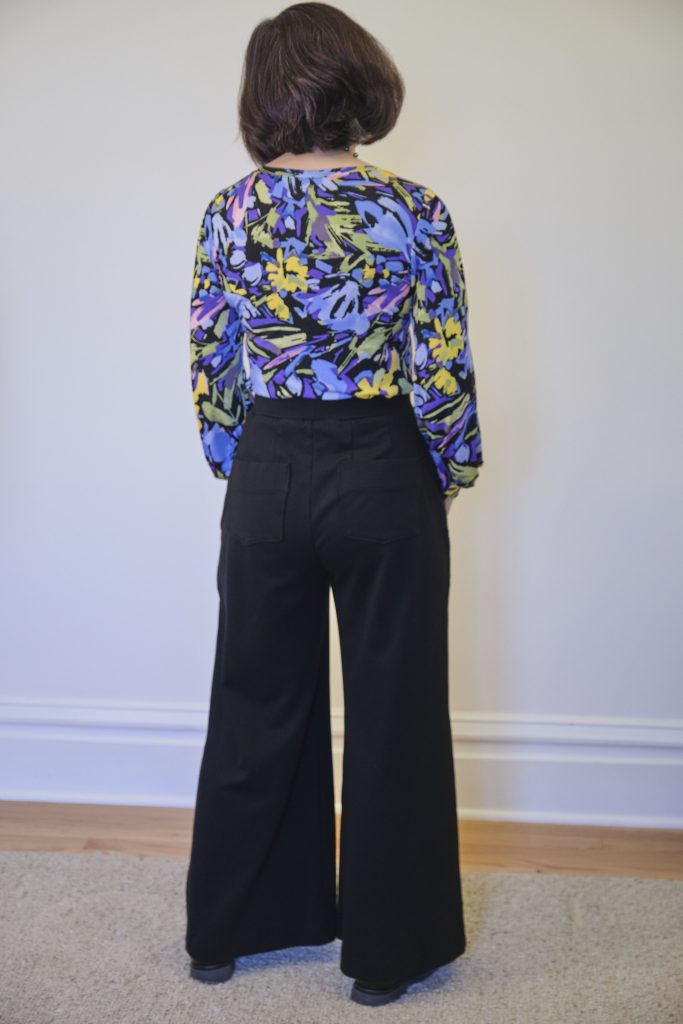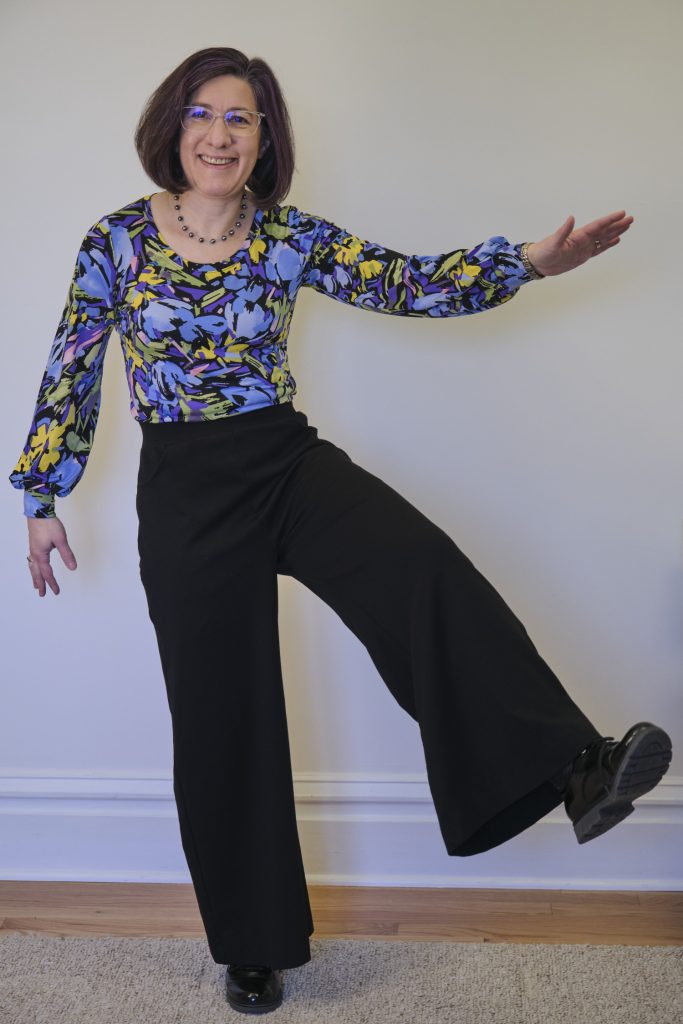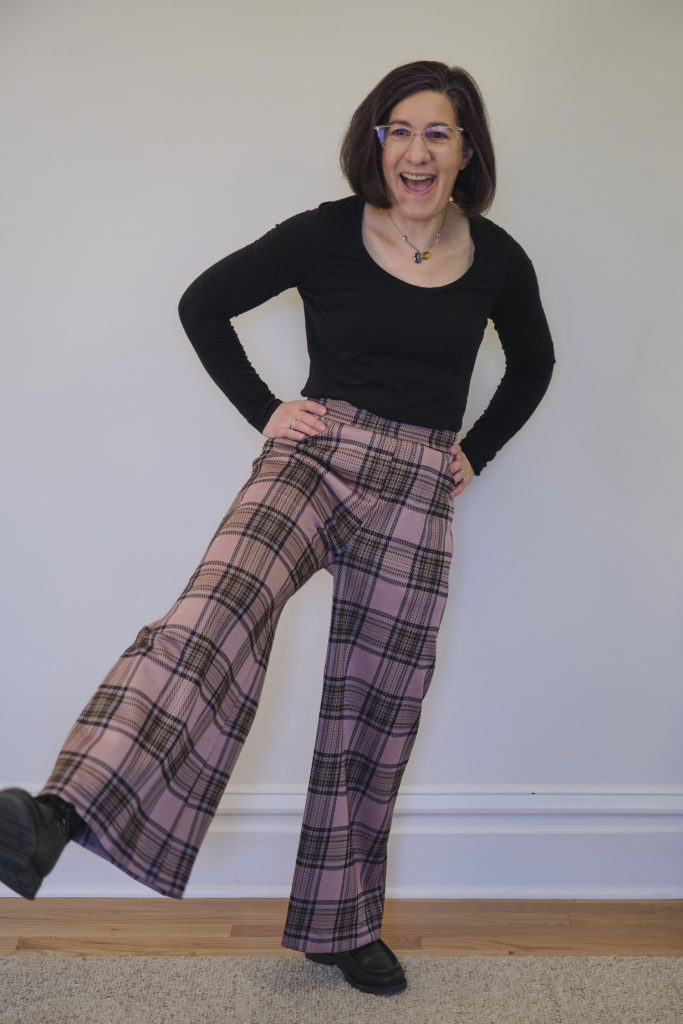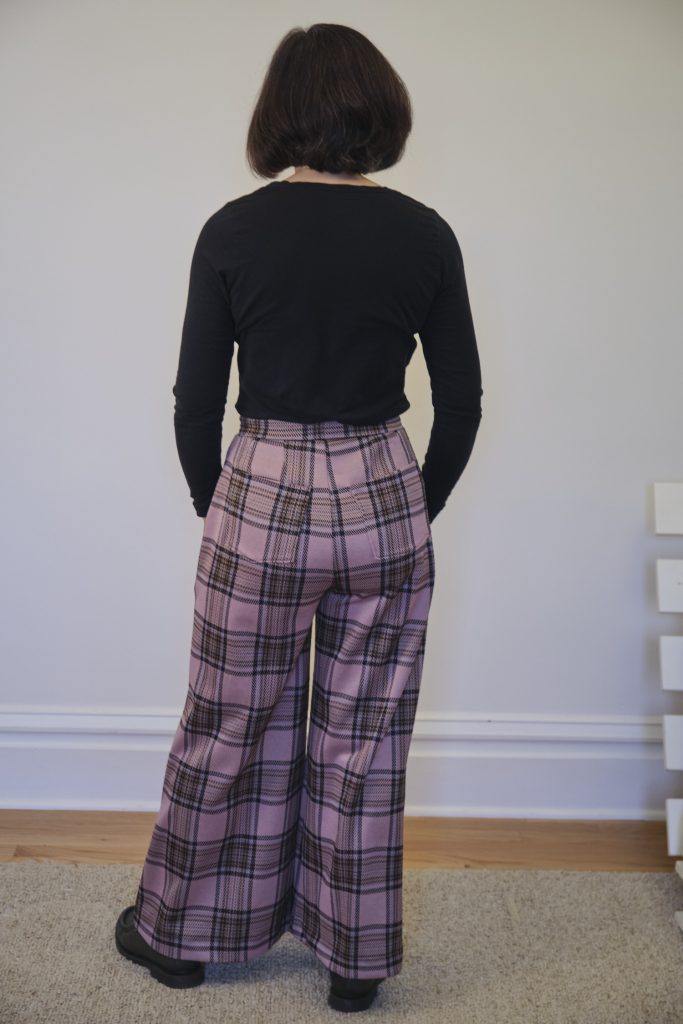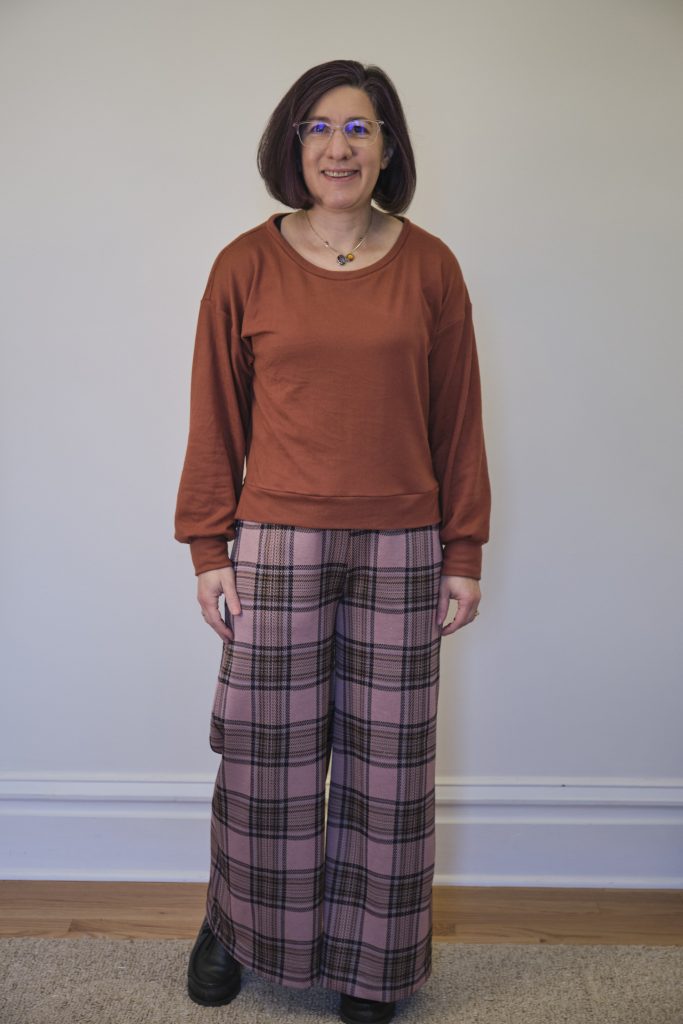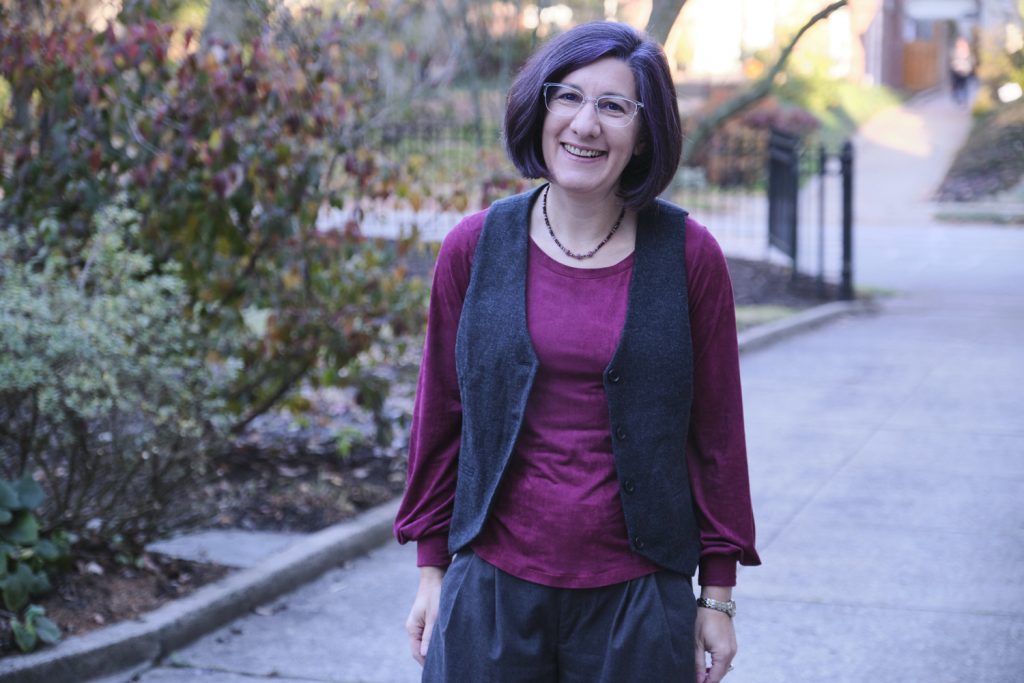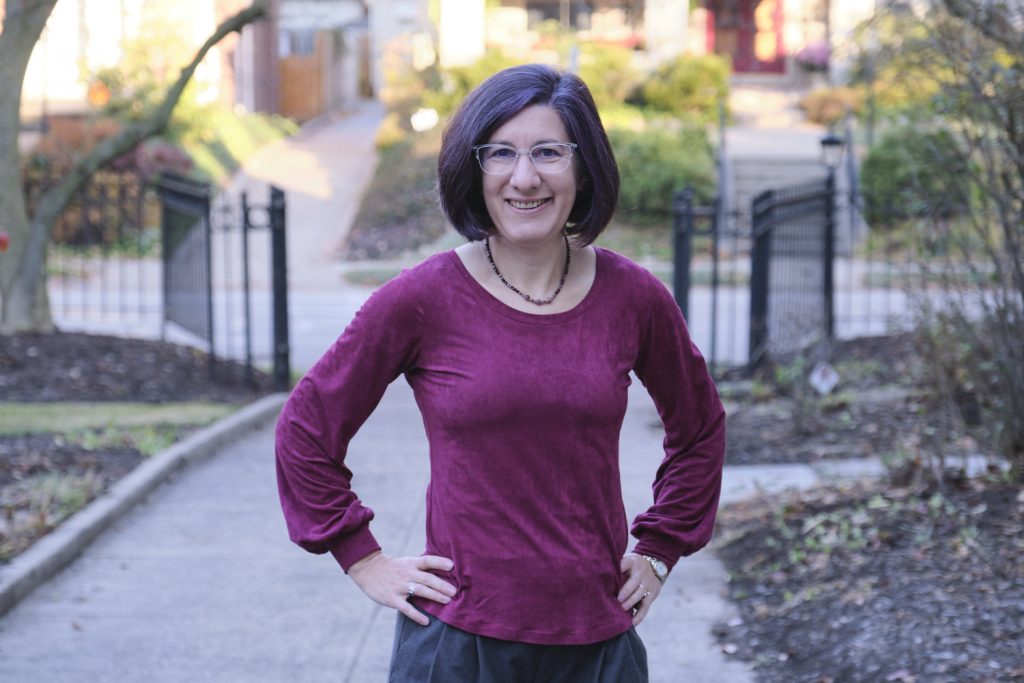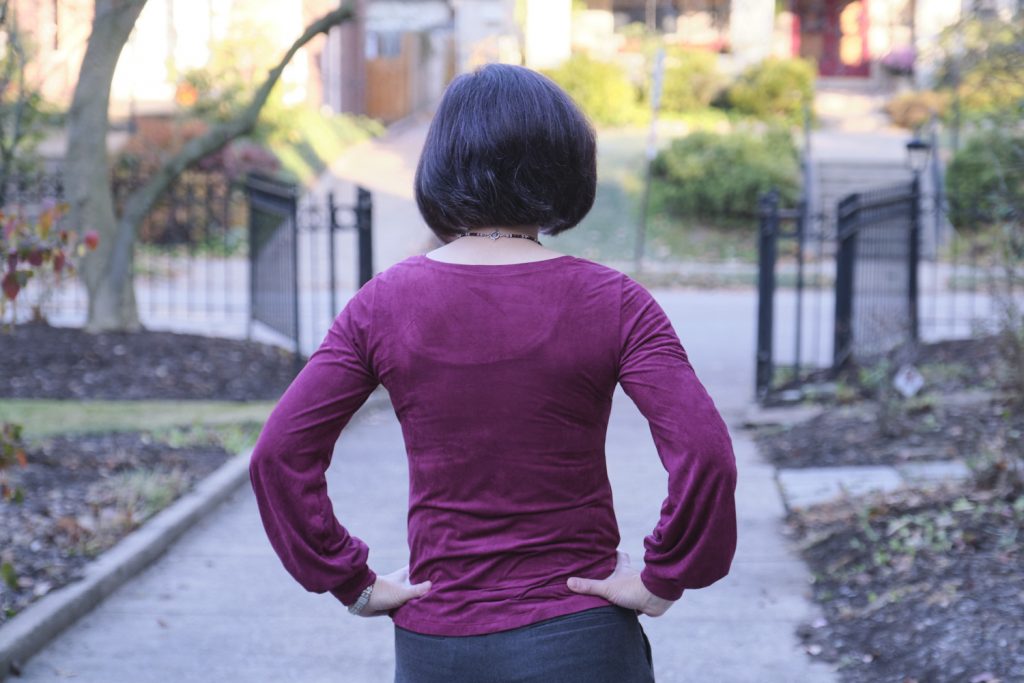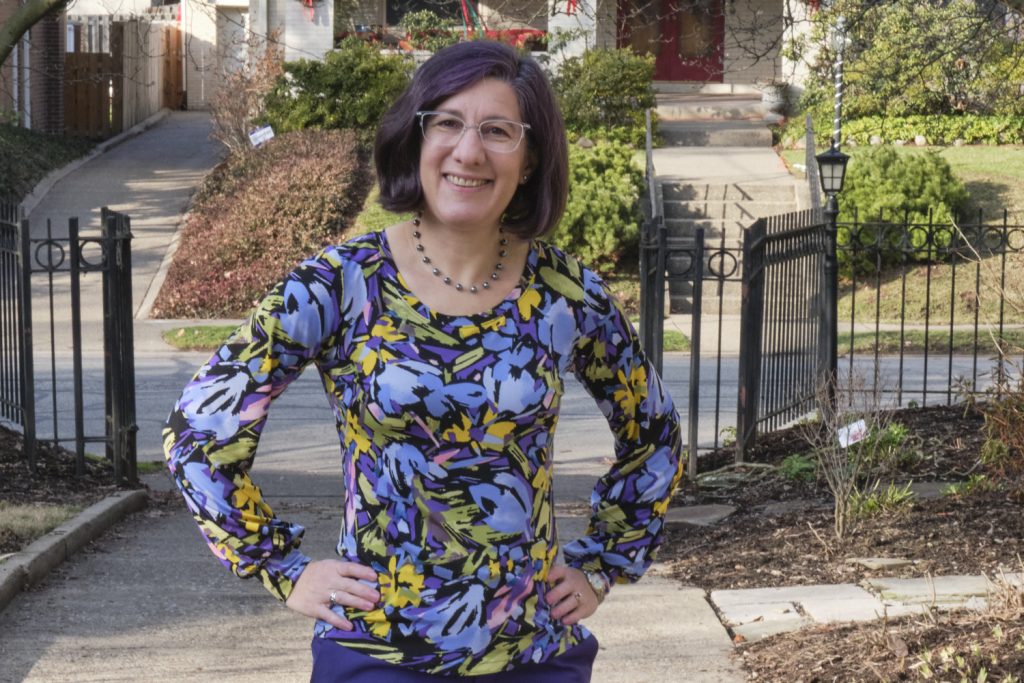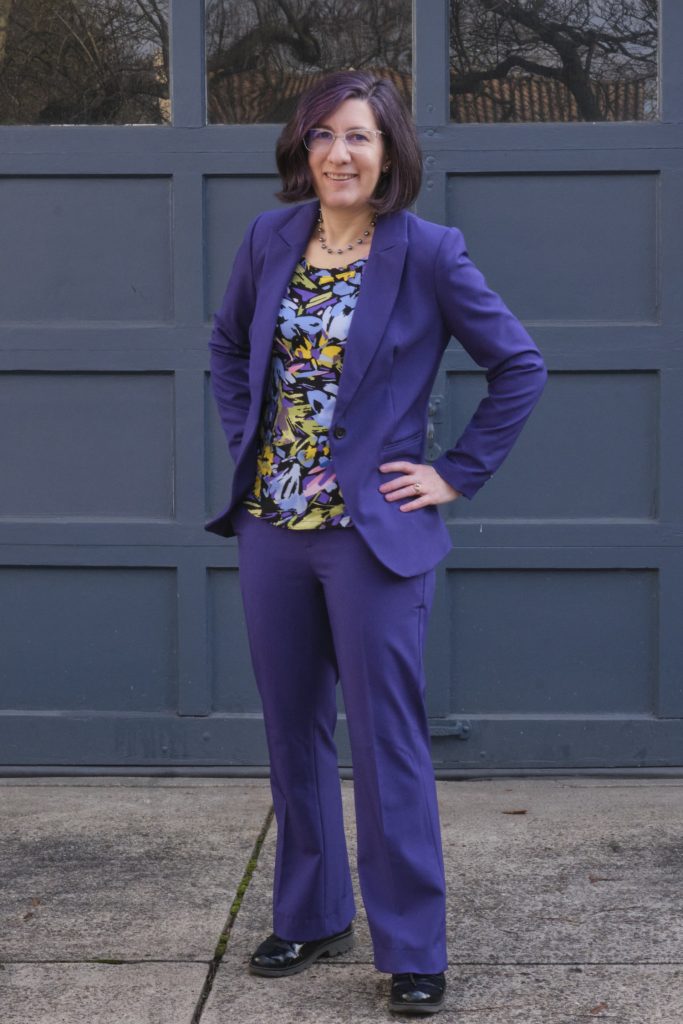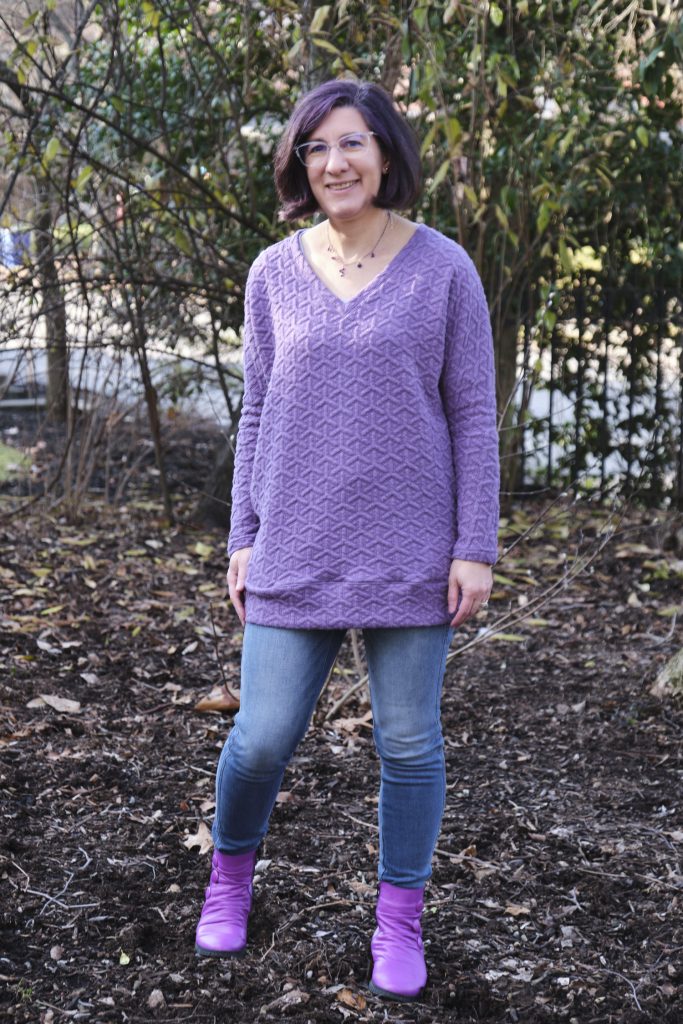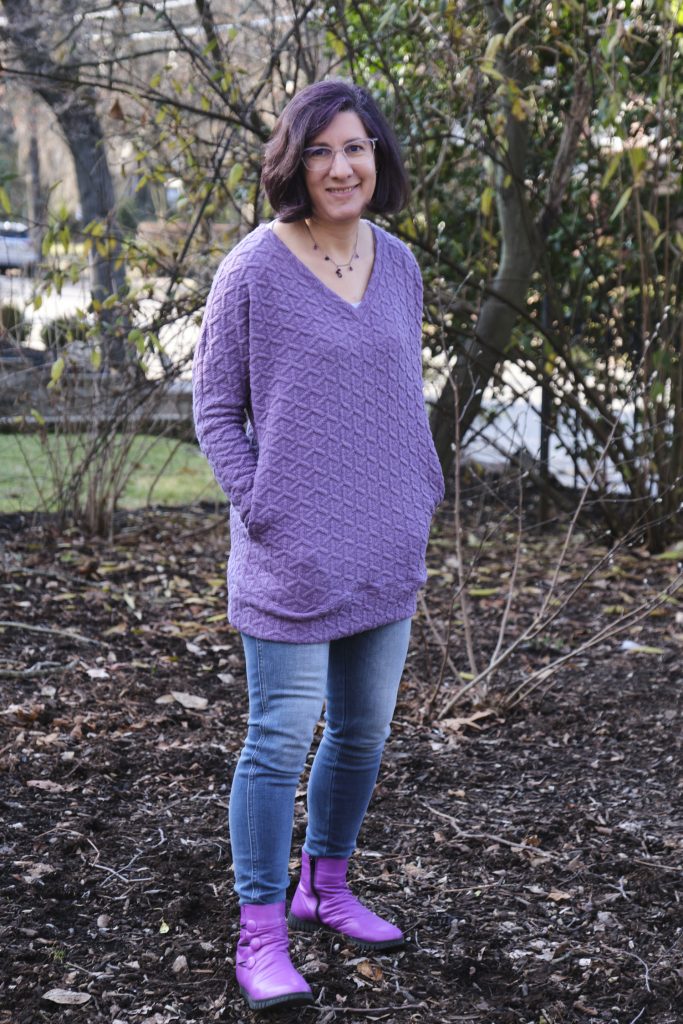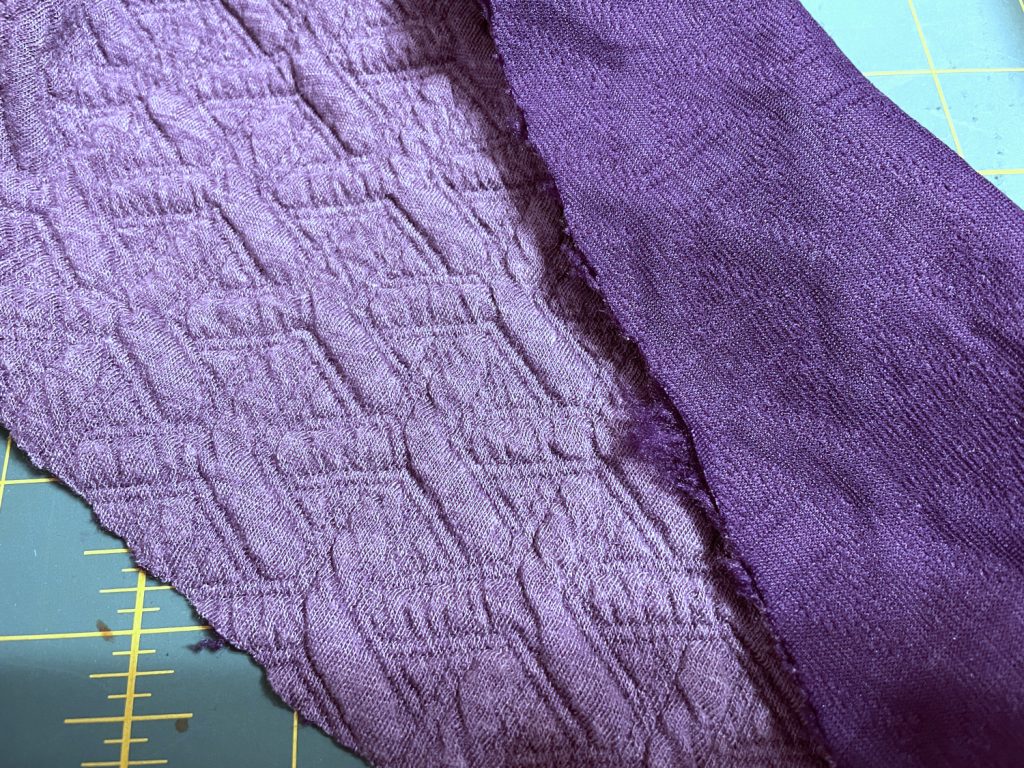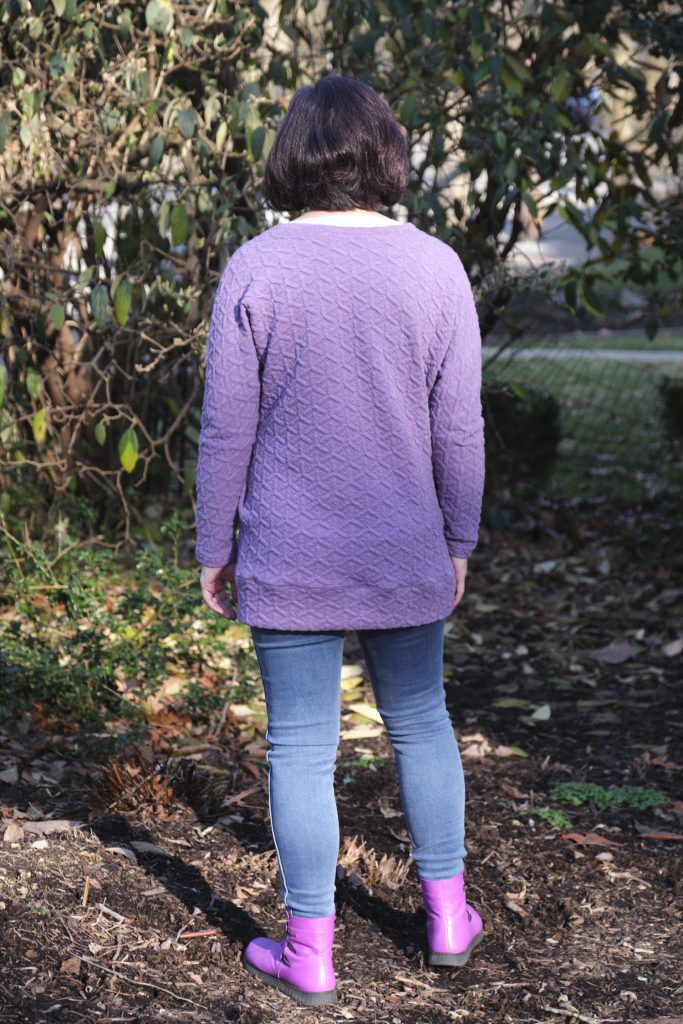Having now successfully made several pairs of wide-leg and palazzo pants, I decided to give slim pants a try. I made two pairs of grey slim pants this week, with two different types of fabric and patterns. Neither came out quite as I had hoped they would, but they are wearable and I learned a lot about pants fitting in the process, and also why I should probably just stick with wide-leg pants.
Take 1: Pattern Emporium Urban Pants Collection
I was so happy with my Pattern Emporium Walk Boldly pants, that I wanted to check out other Pattern Emporium pants. I saw the Urban Pants Collection for knit fabrics, which includes in a high rise with back darts, similar to Walk Boldly, and decided to give the pattern a try. The collection includes wide leg, tapered, and flared pants patterns, all with yoga waist bands and a jeans pocket option.
I selected the tapered style for my first pair. I was originally going to use a grey ponte fabric, but read the warning about the pattern not working well with some pontes, and I decided not to take the chance. Also, the pattern designer highly recommended doing a fit test. So I used some grey cotton lycra from my stash that is soft and comfy but doesn’t have great recovery, so I’ve been reluctant to use it for anything I really care about. I figured it would at least make a comfy pair of PJ pants.
I cut out the pants in size 10 with a size 8 waist band. Since I’m 5’2 I shortened the pants by 2 inches, and because I love big pockets, I added 2 inches to the length of the pocket bags. I also zigzag stitched a circle of half-inch elastic inside the waistband fold because I often have trouble with yoga waistbands staying in place when I put things in my pockets and I prefer the feel of a snug waistband to feeling like my pants are falling down all the time.
The pants went together pretty quickly and easily, and the pattern was easy to follow. The bad-recovery fabric made the pocket construction a little finicky, and cause the top of the pockets to stretch out a bit. My 2-inch pocket extension was probably over kill on these pants and 1 inch would be sufficient. The length ended up maybe a tad short, but they look ok with a 5/8-inch hem (held in place with fusible hem tape and then finished with a narrow zigzag stitch). I could probably have shortened by 1 inch instead of 2.
I struggled a bit with stretching the waistband as I sewed it to the pants with my serger. I ended up with a couple of unwanted puckers, so I unpicked part of the waistband and sewed it again. It worked better the second time, but it wasn’t quite as smooth as I would like. I had pinned it in 8 places, and clearly next time I should add more pins (as the pattern designer recommended). Another option I might consider next time is to split the waistband into two pieces and angle the sides so the bottom is a size 10 and the top is a size 8, which means there is less stretching of the bottom needed. Adding a contour to the waistband could also work.
After finishing the pants, I scrutinized the fit to see if any of the extensive modification described in the pattern tutorial were needed. I thought it looked pretty good as-is, and my husband (who is not afraid to tell me the dress I just sewed looks like a sack) agreed. They don’t cling too much to my bottom or hips. They do cling to my calves a bit, which causes some wrinkling at the knees, so perhaps I should adjust a bit for wider calves.
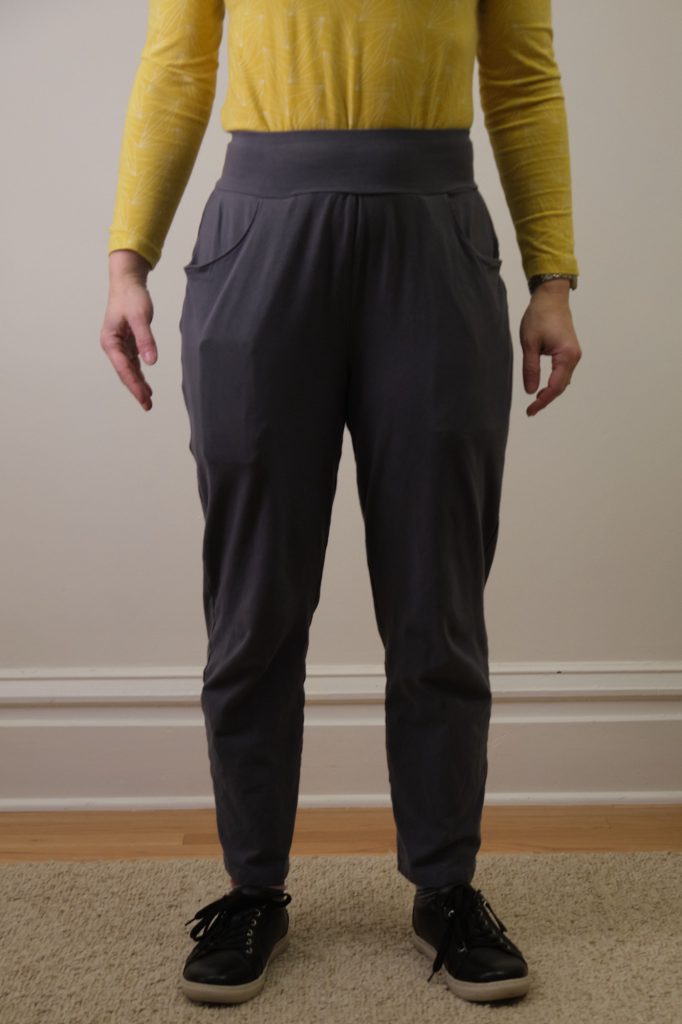
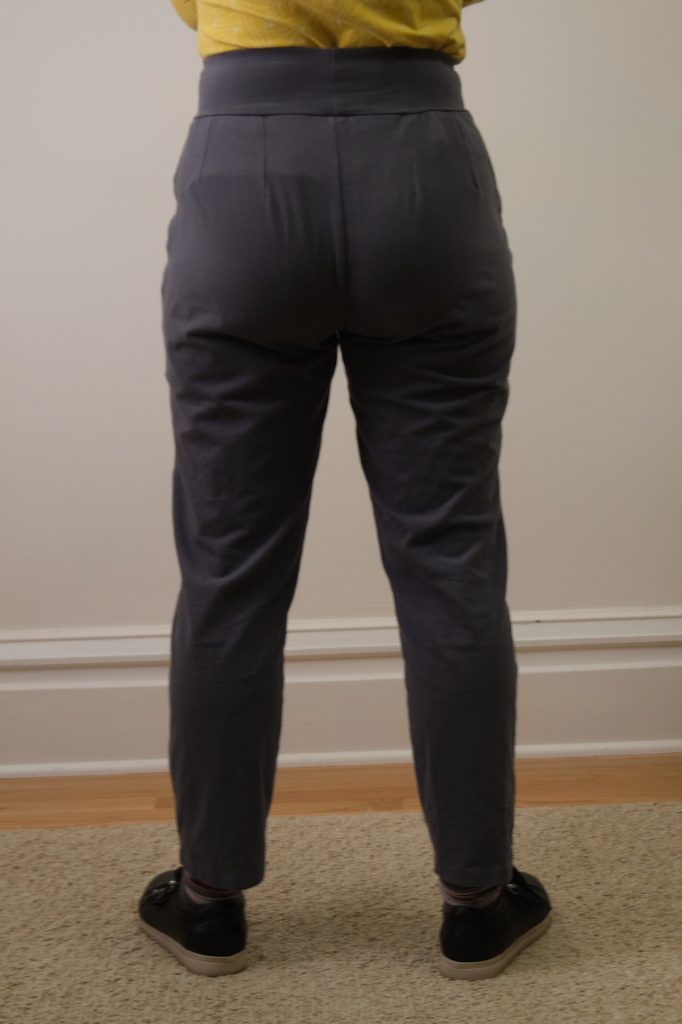
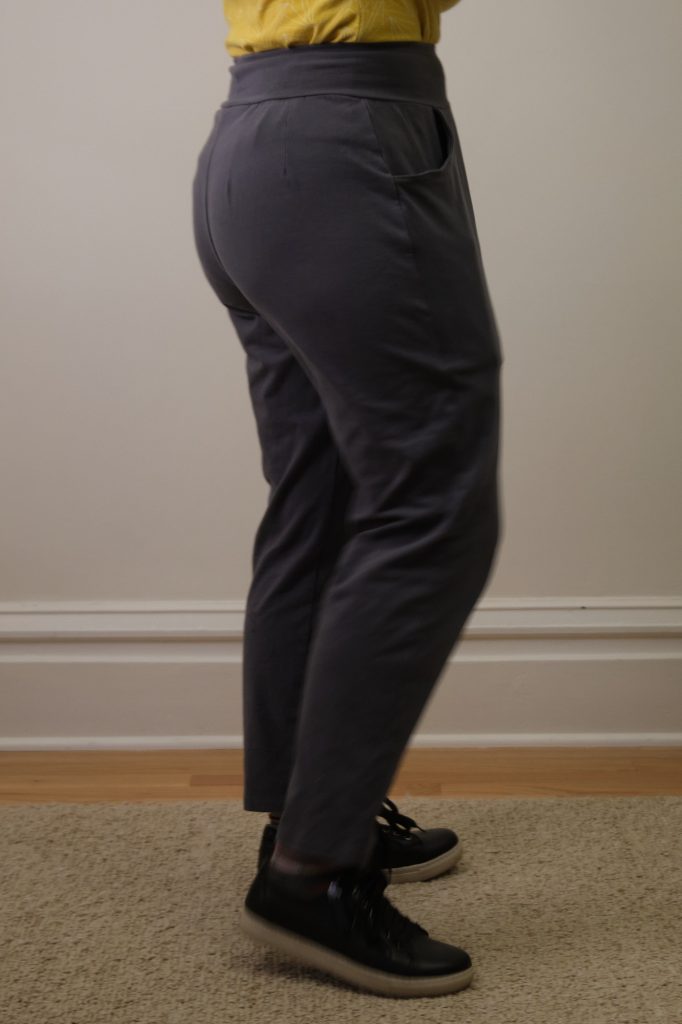
These are pants I will wear with t-shirts on weekends (or as pajamas). The grey CL fabric gives them an athletic vibe, and they look like joggers without bottom cuffs. I like the back darts and the yoga waistband (except for the unwanted puckers. I think they fit pretty well, although I think they look better when my shirt is not tucked in, so that’s how I will likely wear them most of the time.
I would like to try another pair in a dressier looking fabric that has better recovery. I’m still not sure whether these would work well in ponte. I will probably try the wide-leg version in ponte first. The wide-leg style is not as wide or high waisted as the Walk Boldly pants (and it has the same yoga waist band as the tapered style, while the Walk Boldly pants use an elastic waist band), and the Urban pants use a lot less fabric. Unlike the Walk Boldly pants, the Urban pants do not have back pockets, but I think I could borrow the pocket design from the Walk Boldly pants and add pockets to these.
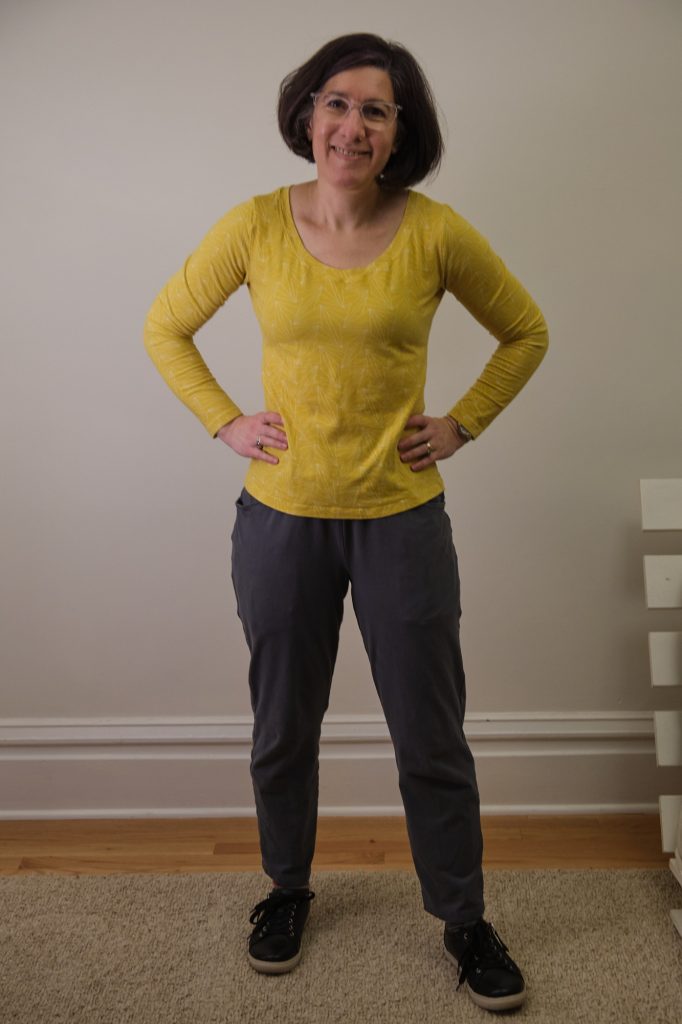

(I modeled the pants above with one of the first Sinclair Bondi shirts I made, and never blogged about, in a yellow cotton lycra print and wide scoop neck.)
Take 2: Love Notions Patterns Sabrina Slims
I still wanted to make a pair of slim pants with my grey ponte fabric, a stretchy 320 gsm viscose/nylon ponte in the wrought iron color from Surge Fabrics. I looked for other slim pull-on pants with high-waist options and pockets that listed ponte among their recommended fabrics. I decided to try the Sabrina Slims pants from Love Notions Sewing Patterns. This pattern is intended for stretch woven fabrics and stable knits. It has jeans pockets and patch pockets, and a 2-inch elastic contoured waist band.
This pattern instructions are a bit terse and the pattern does not come with as many explicit instructions and suggestions or diagrams as some of the other patterns I’ve been using. I have enough experience that this wasn’t a problem for me, but I think it makes this less of a beginner-friendly pattern when there’s actually not much particularly difficult about it. I followed the measurement instructions and selected a size 6 based on my hip measurement, as recommended. I noted that my thighs were size 8 and my waist and calf were size 10 (although based on the finished measurements there is a lot of extra room in the waist so a size 6 waist should be quite ample in a stretchy fabric). I graded the inseam on the front and back pieces to a size 10 but left the rest a size 6. I also extended the pocket bags to have room for my phone. I cut out a 28-inch inseam, which is longer than I expected to need but would give me room for error.
The pattern comes with a fit handbook, which was very helpful. They recommended sewing a muslin for a fit test and offered suggestions for a quick a dirty approach to basting the muslin together. I decided to take a chance and cut my muslin from my grey ponte fabric in the hope that it would be wearable by the time I got done with it. I basted it all together (using the recommended 3/8-inch seam allowance) and tried it on, and was not too happy with it. The front looked ok, but the back was too tight against my bottom, and the sides puckered where my hip crease is, and the fabric had folds around my knees. I read the fit guide but wasn’t entirely sure what to do, so I posted some photos to the Love Notions Pattern Support Facebook group and asked for help. I received a large number of responses, which was great. People pointed out that these pants were fitting me more like leggings. People suggested sizing up and sewing with a smaller seam allowance, offered tips on scooping the crotch or lengthening the crotch seam, noted that the fabric was pulling on my calves, pointed out that I have hip dips, suggested better underwear choices, and wondered whether my troubles were caused by the heavy ponte fabric. They also sent me pointers to a number of pants fitting videos. The “Lifting Pins and Needles” pants fitting video series was very informative.
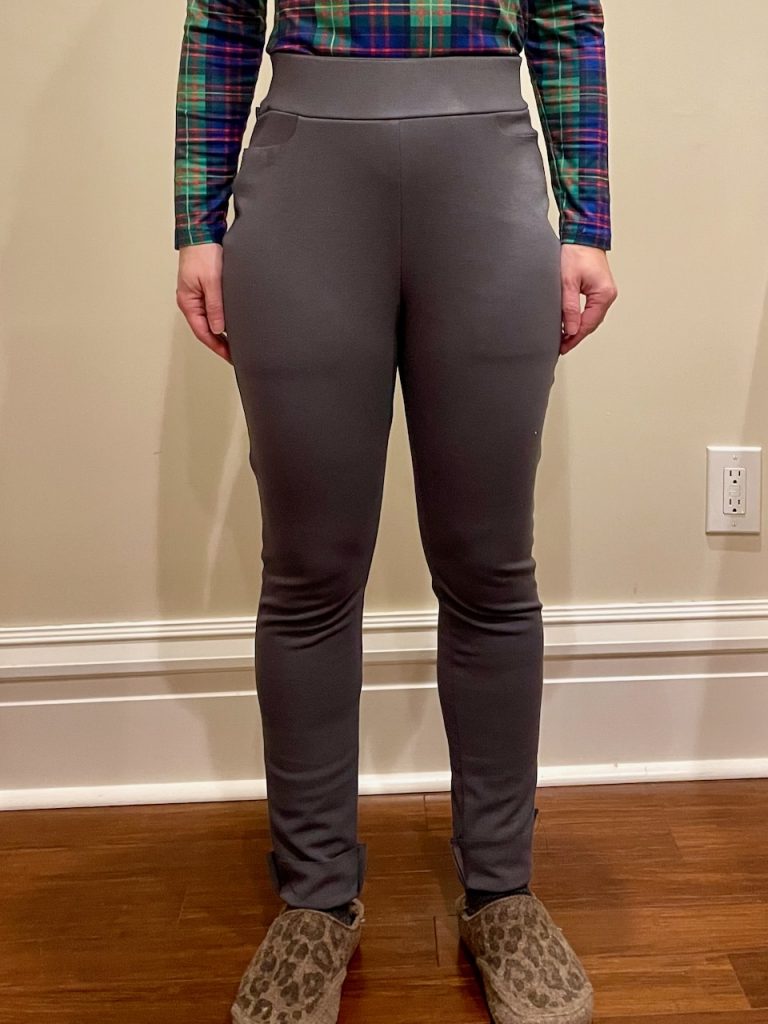
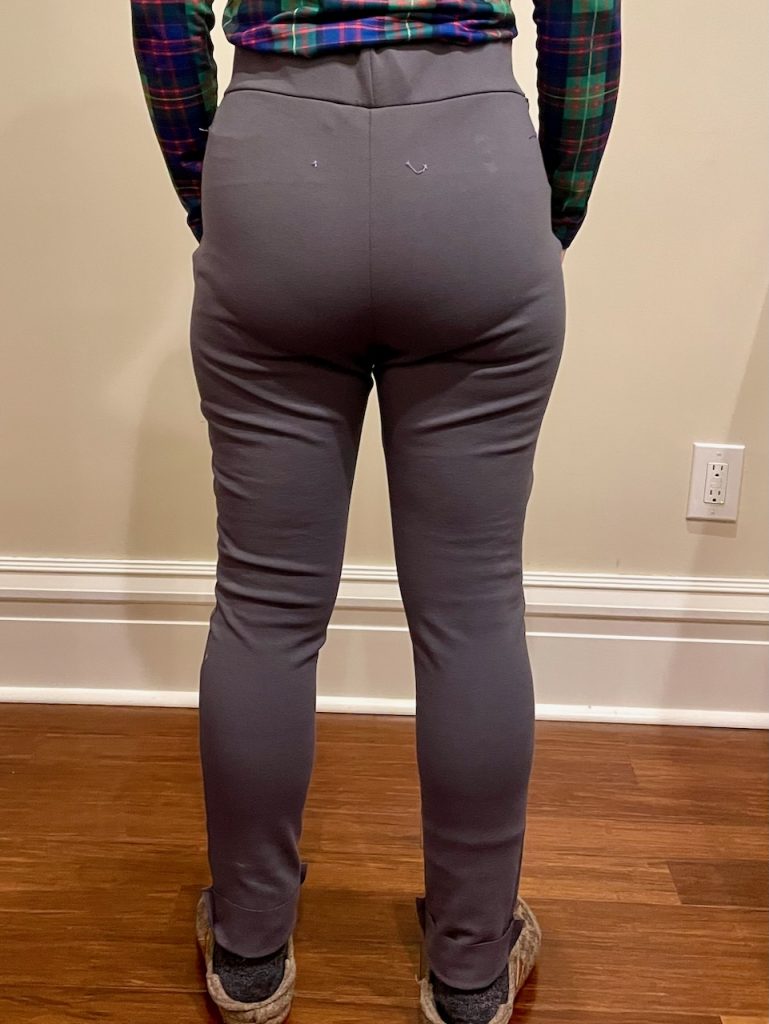
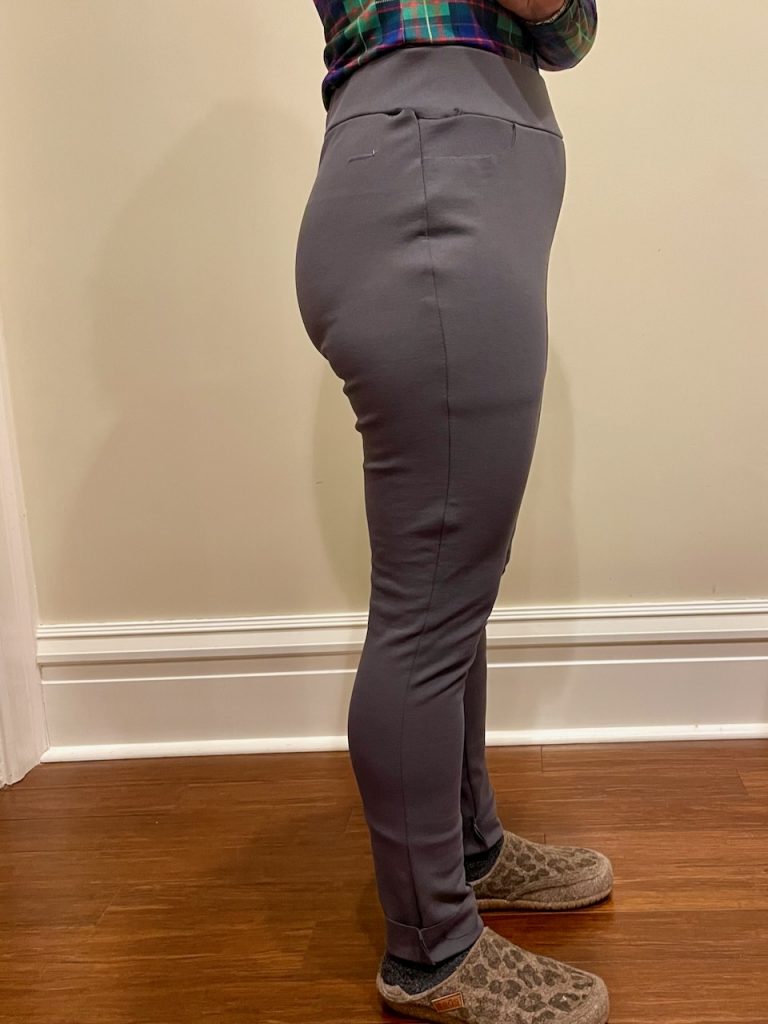
From all this I learned a number of things. First, I had been oblivious to the fact that the shape of my hips has a name (hip dips). Now that I know the name I have learned that my inadvertent discoveries about selecting flattering clothes align pretty well with what people recommend: wear wide-leg pants and fit-and-flare dresses. Next I learned that I have largish calf muscles, something that had never occurred to me before – I don’t think they are enormous, but they are indeed larger than the pattern measurements for my size. Now I understand why none of the slim pants I own are smooth over the knees: they are all getting pulled by my calves. Going forward, I guess I will widen the calves of any slim pants I sew. From the videos, I learned how to measure myself for pants and adjust patterns based on this, something I will do before attempting another pair of slim pants.
I decided to try to salvage the muslin, so I removed all the basting and sewed the pants together with my serger using a 3/16-inch seam allowance everywhere except on the waistband, which makes it closer to a size 8 instead of a size 6. I also did some scooping of the back crotch and I recut the extended pocket bag in purple ITY to reduce the bulk since the ponte is pretty thick.
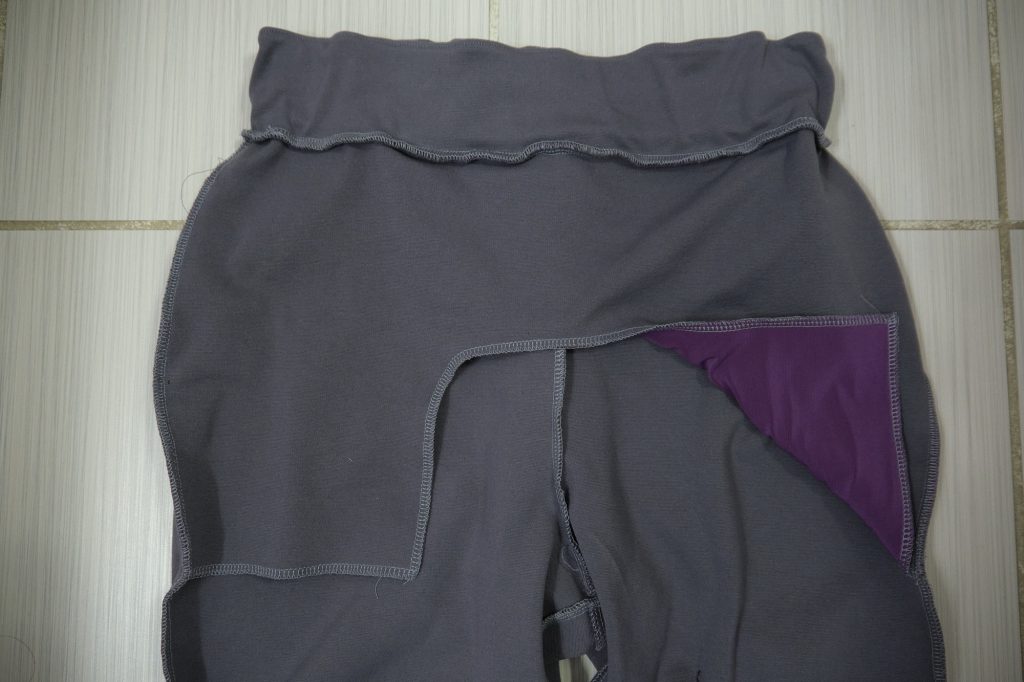
After I got it all sewed together and added the back patch pockets, I tried it on and found that my changes had helped improve the fit somewhat. The back and hips looked better, but my hip dip was still prominent. There was a bit more room in the legs, but still not enough for my calves. I think I may have inadvertently added too much to the front crotch, which you can kind of see in the side view. The patch pockets also served as a camouflage, although I’m not entirely happy with the pocket placement, and would move them closer together, lower the outer corners, and also consider slightly smaller pockets next time (the pattern offers the same size patch pockets regardless of pants size). The waistband did not sit smoothly and was a big disappointment. While I was focussing on making my butt look better I hadn’t noticed the waistband problem, and just assumed the gaps were due to the fact that I hadn’t attached it completely. But now I see that the waistband is actually too big for me and I should have either sized down or added more of a contour. With the elastic it fits and isn’t going to gap or fall down, but it isn’t as smooth as I would like. I decided that the muslin was about as good as it was going to be, so I went ahead and finished the pants, cutting 1 inch off the bottom of each leg and sewing a 1-inch hem (effectively a 27″ inseam).
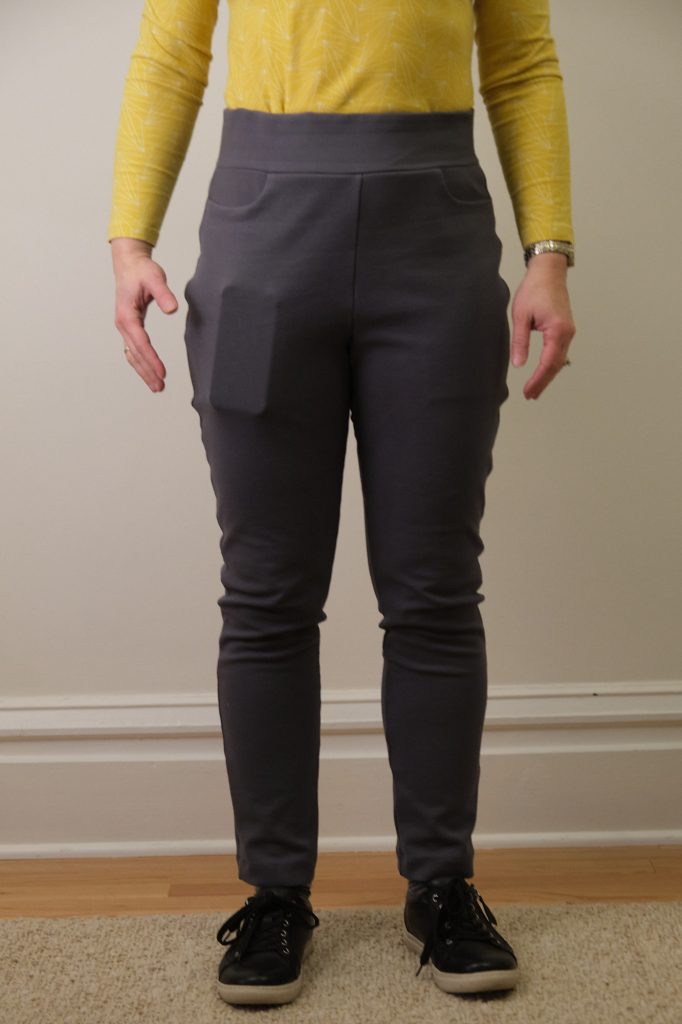
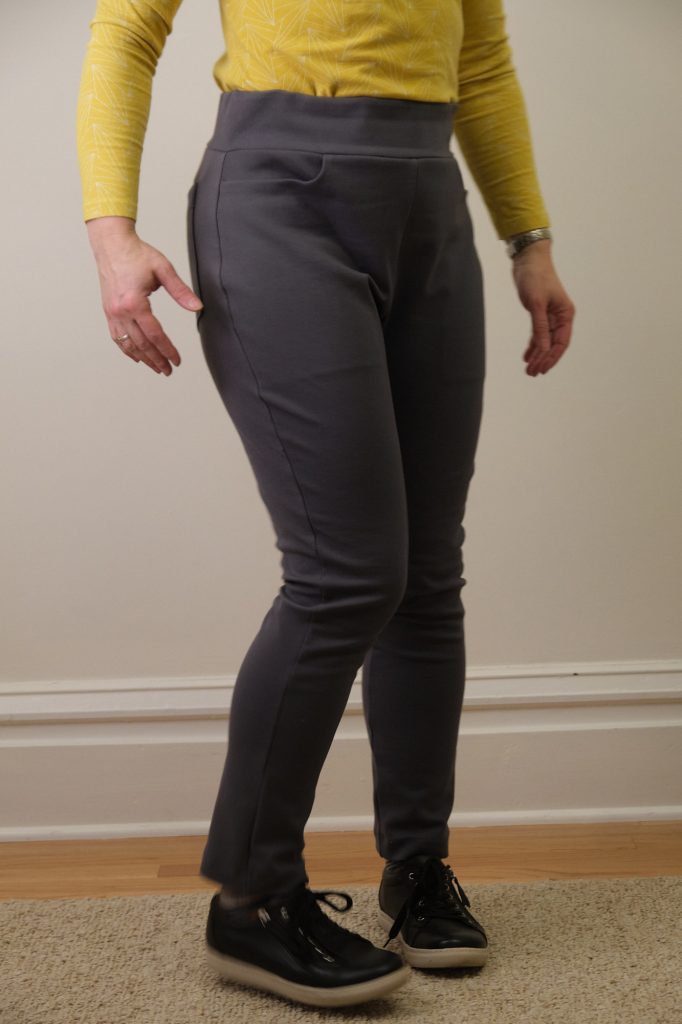
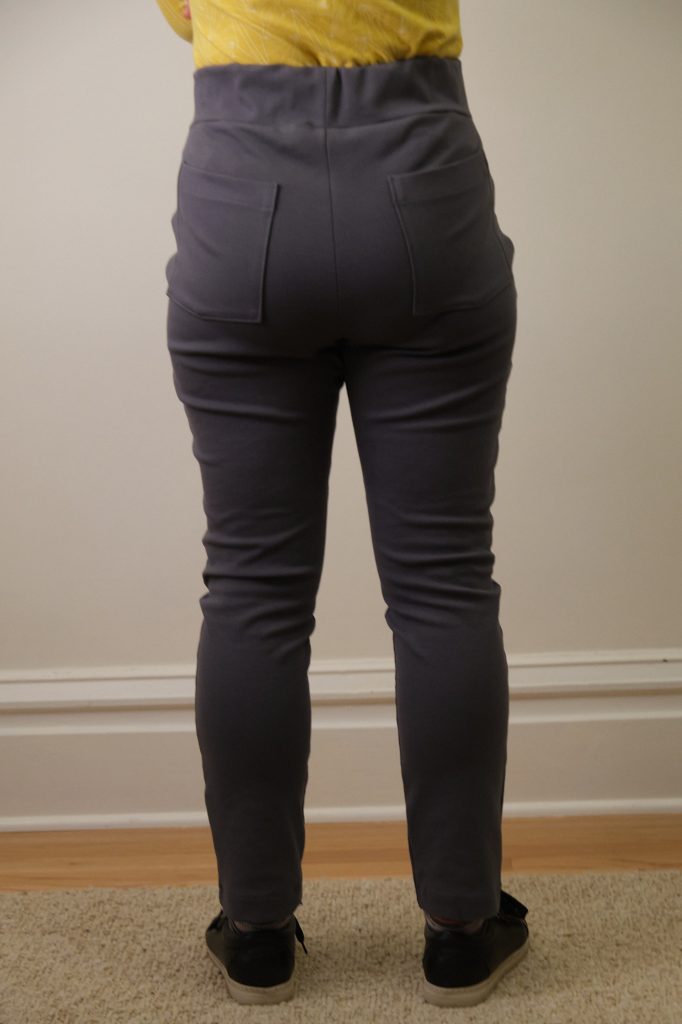
The muslin is wearable and I expect I will wear it, despite the flaws. It looks much better if I wear a longer shirt and don’t tuck it in. I expect I will likely wear these pants with a longer sweater or jacket and they will look fine. The ponte is actually super comfortable to wear and it has a somewhat dressy look.
My sense from reading the Facebook group is that other people did not have as much trouble with this pattern. The pattern states “as sizes get larger, the less negative ease there is.” With less negative ease in larger sizes, I think the pattern would be more forgiving. My choice of fabric may have played a role in my difficulties, but I’m not sure. And in the end, although these pants do not have my ideal fit, they fit similarly to most of the slim fit pants I have bought in a store. So maybe Ill make more adjustments and try again, but probably I’ll go back to wide-leg pants for a while.
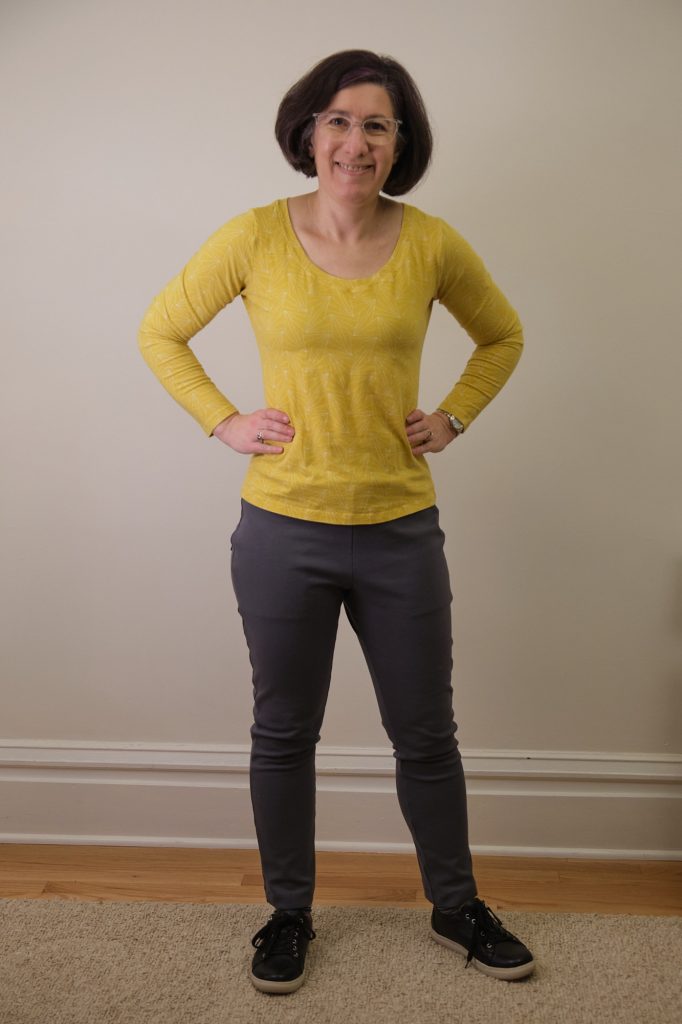
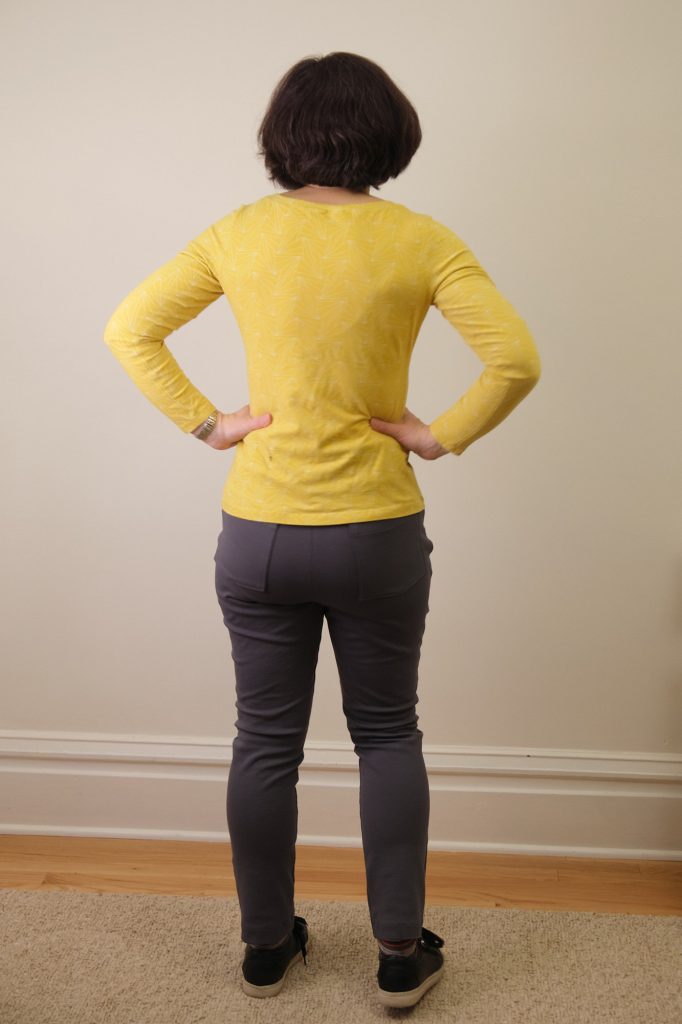
Conclusions
This wasn’t a controlled experiment because I used very different fabric for the two pants. Nonetheless, I can make some comparisons. The Sabrina Slims are a slimmer style: the Urban tapered pants include a lot more ease. I expect to make the Sabrina slims look better on me would require a number of adjustments to the crotch, waistband, and calves, while the Urban tapered pants would likely need only a more minor calf and waistband adjustment and optionally the addition of back pockets. The back darts and fit with more ease are likely going to make it easer to get a good fit on the Urban pants for me and I am curious to see how they will look in ponte. However, I do like the slim look and it may be worth making more adjustments to the Sabrina Slims to get a slim pants pattern I can use for both dressier pants and pull-on jeans. Or maybe I’ll just stick with wide-leg pants for a while.
Update, 1 week later
So I wore the Sabrina Slims to work with a long jacket, and loved how comfortable they were. They feel like secret pajama pants (and after my daughter suggested it, I discovered that I could fit a water bottle in one of the back pockets). Most of the flaws I wrote about above didn’t really bother me, but I was still unhappy with the waist band. So after running through the wash, I took a pair of scissors and cut off the entire waist band. Then I cut off the bottom stitches, removed the elastic, and reduced the circumference of the waist band by about 2 inches. I carefully basted and then sewed the whole thing together. Now the waist band was smaller than the pants, so I had to stretch it as I sewed, similar to sewing a yoga waistband. Because I cut the waistband off instead of unpickiing it, I lost about 3/4-inch of rise in both the front and back. However, I realized from wearing the pants that I had more rise than I needed. Then I threaded the elastic back in and tried on the pants. I think they look a lot better now, despite a wee bit of puckering in the back. There are still some issues that I will try to address when I make this pattern again (more tweaking of the crotch and seat, more room through the thighs and calves, slightly smaller and better placed pockets), but I’m now pretty happy with these pants and I expect I will wear them frequently.
